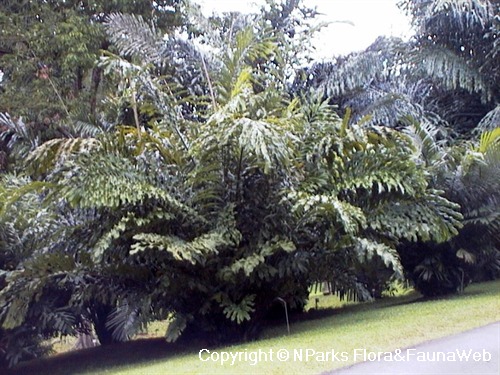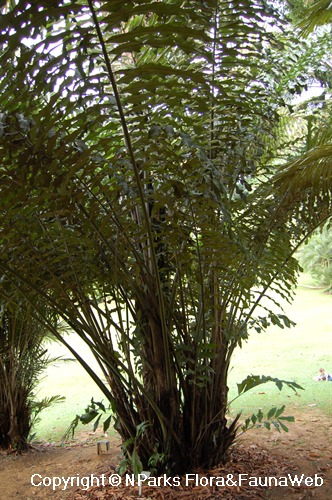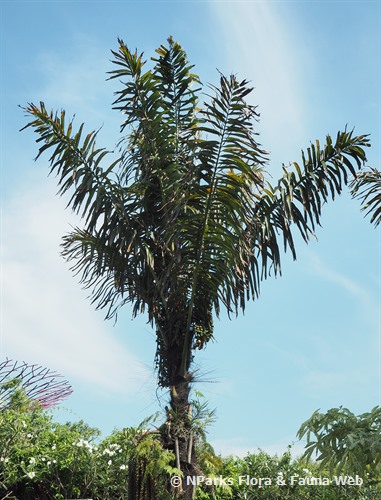
Back
Arenga hookeriana
| Family Name: | Arecaceae (Palmae) |
| Synonyms: | Acanthophoenix hookerianum |
| Common Name: | Hooker Fishtail Palm, Hooker's Sugar Palm, Sri-Sa-Yarm |
Name
Classifications and Characteristics
| Plant Growth Form | Palm (Clustered Habit) |
|---|---|
| Mode of Nutrition | Autotrophic |
| Maximum Height | 1.8 m |
| Maximum Plant Spread / Crown Width | 1.6 m |
Biogeography
| Native Distribution | Thailand & Malaysia |
|---|
Description and Ethnobotany
| Growth Form | A small, relatively fast-growing, clumping palm with multiple cane-like stems. |
|---|---|
| Foliage | Fronds are either simple or shortly-pinnate, up to 0.6m long. Leaves or leaflets undivided, paddle-shaped, with deeply-lobed and sharply-toothed margins, green and glossy on the upper surface and silvery or whitish beneath. |
| Others - Plant Morphology | Flower: Flowers creamy white to orange, emerging as simple, erect spikes in clusters from the nodes. Fruit: Fruits reddish orange when ripe, globular, about 1 cm across, each subtended by a persistent orange calyx. |
| Cultivation | Tolerates poor soils but prefer well-drained soils. Propagate by seeds (seeds take 8 to 16 weeks to germinate) and division. |
| Etymology | Genus epithet 'Arenga' derives from the Javanese name aren, used for a palm of this genus. Species epithet 'hookeriana' is named after J.D. Hooker, 19th century English botanist. |
Plant Care and Propagation
| Light Preference | Semi-Shade, Full Sun |
|---|---|
| Water Preference | Moderate Water |
| Plant Growth Rate | Moderate |
Foliar
| Mature Foliage Colour(s) | Green |
|---|---|
| Foliar Shape(s) | Palm Fronds (Simple) |
| Leaf Area Index (LAI) for Green Plot Ratio | 4.0 (Palm - Cluster) |
Non - Foliar and Storage
| Trunk Type (Palm) | Clustering Habit, Aboveground |
|---|
Floral (Angiosperm)
| Flower Colour(s) | Cream / Off-White, Orange |
|---|
Fruit, Seed and Spore
| Mature Fruit Colour(s) | Orange |
|---|
Image Repository
Others
| Master ID | 1299 |
|---|---|
| Species ID | 2592 |
| Flora Disclaimer | The information in this website has been compiled from reliable sources, such as reference works on medicinal plants. It is not a substitute for medical advice or treatment and NParks does not purport to provide any medical advice. Readers should always consult his/her physician before using or consuming a plant for medicinal purposes. |







